Pinasuvvimuulingajunik Pigiursatitaunirmut Arqusiurniq
About the Work Oriented Training Path
The Work Oriented Training Pathway (WOTP) offers students two alternative pathways from the regular program. Both the Pre-Work Training (PWT) and Semi-Skilled Trade (TST) programs lead to a Quebec Ministry of Education (MEQ) certification, often bridging them directly to the workforce or towards vocational training, rather than CEGEP or other post-secondary education programs.
Pre-Work Training Program (PWT)
The Pre-Work Training Program (PWT) is a 3 to 5-year program of 2700 hours where students learn a variety of skills through work placements and project-based learning environments. It is designed for students who, at 15 years of age (or older), are progressing at an elementary level in their literacy and numeracy skills (grade 7 or lower).
The goal of PWT is to offer students a gradual and supportive transition into work and community life. Students who successfully complete the PWT program receive an official Prework Training Certificate (PWTC) from the Ministère de l’Éducation du Québec, which attests to their overall employability skills.
Additionally, students have the opportunity to transition into the Training for a Semi-skilled Trade program in the final year of the PWT program.
Training for a Semi-Skilled Trade (TST)
Training for a Semi-Skilled Trade (TST) is a 1-year program of 900 hours where students develop specific competencies of a single semi-skilled trade. It is designed for students who, at 15 years of age, are working at a level of secondary cycle one in English Language Arts and Mathematics.
The program offers focus on the three core academic subjects: First Language, Second Language and Mathematics, while training for a specific Semiskilled Trade at the same time. A work placement is mandatory towards the completion of the program. The objective of this program is to provide students with experiences and qualifications for a specific field of work.
Students who successfully complete the TST program will receive an official Training Certificate for a Semiskilled Trade (TCST) granted by the Ministère de l’Éducation du Québec. The TCST indicates the specific Semiskilled Trade in which the student received training.
For more in-depth information, you can consult the draft version of Kativik Ilisarniliriniq WOTP Handbook for Administrators, Teachers and Employers. The finalized Handbook will be released when translation is available.
Education Consultants
Cory V. Burlingham

Education Consultant, Work-Oriented Training Pathway, Kuujjuarapik
Email: coryb@kativik.qc.ca
Phone at Asimauttaq School: 819 929-3409
I am originally from Sarnia, Ontario. I completed my Bachelors of Education at Western University, and I studied Art and Art History at the University of Toronto. I began teaching in Nunavik in 2015. I was originally hired as the visual arts teacher. After two years I shifted my position to the Nurture Group, working with students who have developmental disorders. In 2019, I rolled out my school’s first WOTP program. In 2020 we began the process of standardizing the WOTP program and making it more accessible to teachers and students across Nunavik.
Vacant 2023-24
Here is a brief summary of the major differences between the two programs;
| Pre-Work Training | Training for a Semi-Skilled Trade |
|---|---|
| Duration: 3-5 Years | Duration: 1 Year |
| Age of acceptance: 15 – 21 | Age of acceptance: 15 – 21 |
| Objectives of the program: Explore the job market Learn a variety of work-related skills Allow students to learn about themselves and their abilities Develop student’s numeracy and literacy skills through project-based learning or in regular class | Objectives of the program: Learn specific competencies and skills linked to a specific semi-skilled trade Develop student’s numeracy and literacy skills through project-based learning and in regular sector classrooms Develop competencies in Languages and Math at secondary 1.1 or 1.2 levels |
| Work Exploration: Work placement is not mandatory, but strongly encouraged where available Job Observation and research Visiting different work places | Work Placement: Work placement is a mandatory component to completion 375 hours of training Work training must match a specific approved semi-skilled trade |
| Certification: Pre-Work Training Certificate (PWTC) | Certification: Training Certificate in a Semi-Skilled Trade (TCST) |
Table of Content
The Students
Strengths
Students in WOTP have a great number of strengths and abilities that are not normally expressed in the regular classroom. They tend to prefer hands-on learning and demonstrate their knowledge and skills when interacting with physical materials and in project-based learning. They have strong foundations in their cultural practices on the land and will incorporate this experience when creating solutions to problems. Many of them are the oldest siblings in their family playing a leadership role in their household and thus have strong family values.
Some students are unsure of their strengths and passions and may hide their strengths to avoid attention. Building a mutual respect between the teacher and student will create a space to uncover and nurture those skills and gifts. All of them are strong-willed and determined to succeed, all of them have the potential to learn, and with a reliable teacher’s guidance and support they will.
Student Needs
Just as students have areas of strength they also have areas of need. These should be documented in the student Individual Education Plans (IEP). If they are not, the special education committee will need to start the file at the beginning of the year. The committee consists of the teacher, the special education teacher, the principal, the student and the parents or guardians and any member of staff that is immediately involved with the student’s education. Students in WOTP are likely to have a combination of exceptional needs impeded their success in the regular sector.
A review of past work samples, medical documents, report cards and previously used IEPs should be employed to create a new IEP to support the student.
Categories
KI recognizes 4 categories of student exceptionality. Only three of them apply to the context of the WOTP and only if there is evidence of a significant academic delay. Your class list will specify which students have which needs. If there are none, the special education team must meet to specify what areas of learning the student struggles with.
- Students with Learning Difficulties
The student has a diagnosed condition that affects their ability to learn. These students may be weak in certain subjects but strong in others. They may have motor-skill or speech impairments. These kinds of exceptionalities can only be diagnosed by a healthcare professional. Without testing, accommodations can still be made for these students through observation and consultation with your Special Education teacher.
- Students with Behavioural Disorder
The student exhibits a specific behavioural pattern that interferes with the regular routine of learning. Strategies and details should be found and updated regularly in the student’s IEP.
- Student who is At-Risk
Students who are categorized as at-risk have a high potential for dropping out of school or experiencing high levels of absenteeism. For students with this classification, it is imperative that they attend school and feel included in order to benefit from the resources available; Student support professional, extra curriculars, student councilor, general education, special education. The special education committee should create an intervention plan and someone in the staff should keep routine checks on the students state.
Whatever category your student is classified as, consider students in WOTP as vulnerable and guide them with patience and compassion.
Students who should NOT be enrolled in WOTP?
Please note that the parental authority overrides any and all decisions about the students educational program unless they are 18 years or older. A student can be entered or removed from the program at their parents/guardians request. It is the responsibility of the school to inform the parent of the limits inherent in the program. WOTP is a modified program, that does not finished with a Secondary 5 diploma.
- Physical handicaps are not grounds for enrollment in to WOTP unless the student is also affected by one or more of the exceptionalities listed above.
- Students with poor attendance should not be placed in WOTP solely on those grounds, one or more of the above exceptionalities must be present. Success in WOTP is dependent on attendance.
- Students without an IEP should remain in the regular sector until they are properly evaluated and coded as requiring a modified program.
WOTP Courses
The following is the specific schedule of classes offered to PWT and TST according to School Operations for the 2021/22 school year.
For more information on the different subjects, you can click on them to go to their respective information page. It is to be noted that some subjects are specific to WOTP and have a specified curriculum, where other subjects such as physical education, inuktitut, arts, culture, CCD and TST mathematics follow the regular curriculum.
PWT

TST
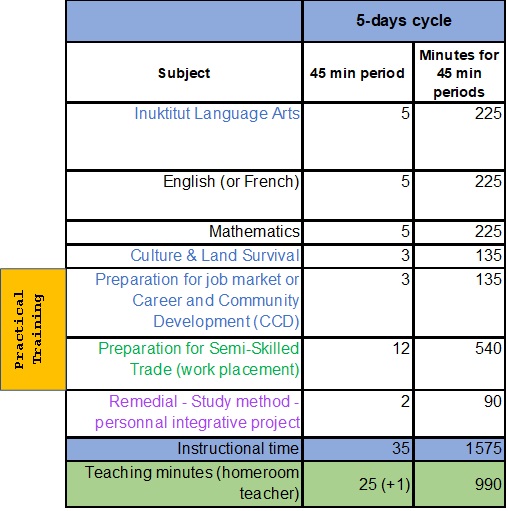
The curriculum competencies of TST for languages and mathematics is the same as cycle one.
Online Resources
This document presents various online resources that can be used in various courses.
Work Training Courses (PWT)
Work training is not counted as part of the general education, this time is strictly practical training. The work training is now divided into 3 different courses with specific objectives.
- Work Skills
This course represents the bulk time of the practical training. This is the time where students experience and participate in real work situations. Examples of this work could be, stocking shelves at the Coop, assisting a daycare worker, preparing meals for elders, entrepreneurial activities.
*Keep in mind that whatever activities are available to you in your community, the students are not to be left to work alone. They are minors and require supervision from either the employer or the teacher. In the event that the employer oversees the student the teacher is still responsible for the student.
- World of Work Orientation
World of work orientation represents a small portion of the practical training which focuses on the employment opportunities of the community and region, as well as investigating the requirements for employment and the possibilities of continued education after high school.
It is important for WOTP teachers to familiarize themselves with their community and the overall vision of the Nunavik region. Getting in touch with the Adult Education and Vocational Training department is also a way to further understand the opportunities for your students to pursue their work interests.
- Preparation for the Job Market
also known as Job Prep, this course holds two functions in the practical training. This time is used to develop the students sense of self and take stock of their abilities through the creation of a CV or portfolio, and second, it is a time to review and share the students work related experiences, successes, failures and overall status of their training. Teachers should use this time to gauge student success and satisfaction with their training.
For more information about the specific learning goals of the Work Skills courses you may review the ministry document below.
Specific Courses for Semi-Skilled Trade (TST)
- Preparation for a Semi-Skilled Trade
The work training is the most vital part of the student’s education in the TST program, without it, the student cannot pass. The nature of the work must apply to the standards specified in the ministry competencies but it must also appeal to your students’ interests.
The competencies for each semi-skilled trade is located on the ministry directory. While it is not mandatory to complete 100% of the competencies, the student must complete the majority of these tasks by the end of their training. Note that some of the trades do not apply to Nunavik, below is a list of trades that are possible in your communities. At this time the ‘Fur-Trapper’ semi-skilled trade is not a possible option in Nunavik as the specific animals required to fulfil the training are not available in Nunavik.
KI List of possible Semi-skilled Trades
Ministry of Education Directory of Semi-Skilled Trades
- Preparation for the Job Market
In addition to work training, TST also has three periods a week for Preparation for the Job Market. During this course the teacher should routinely take time to review the student’s progress in their competencies and ensure the student is receiving a quality experience.
The Directory of Semi-Skilled Trades is a trade inventory organized by occupational sector. It gives:
- a brief description of each trade
- its field of application
- the various job titles associated with the trade
- the conditions required to practise the trade (age, driver’s licence, etc.).
This link will bring you to the complete list of trades.
This link will bring you to the directory with detailed information about each semi-skilled trade and the specific competencies that must be developed.
Nunavik Job Directory
To inform your students about the different jobs that are available in each of the communities, you can use the KRG job directory. It details 175 different jobs with a description and qualification requirements.
The Nunavik Directory of Semi-skilled trades is not an official document recognized by the ministry, however, it can be used to help teachers and students explore the different trades within the context and application of Nunavik.
Project Based Learning
Throughout the general education portion of the WOTP programs, Project Based Learning (PBL) is strongly encouraged to facilitate student learning goals. The traditional academic stream has failed to bring out the potential of your students for multiple years, it is unreasonable to expect the students to continue down that path.
Edutopia.org describes Project-based learning (PBL) as “a dynamic classroom approach in which students actively explore real-world problems and challenges”. The learning objectives of each general education subject can be accomplished by combining subject material with an activity or project that demonstrates the specific learning goal they need to attain to be functional and contributing members of the work force.
By working on a project over an extended period of time, students will engage in solving a real-world problem or answering a complex question.
Exceptionally, there should still be some traditional sit down academic style classes, but the bulk of the academic learning should be experienced through guided activities.
This 4-minute video summarizes straightforwardly the concept.
Dash, your Tool for Attendance and Report Cards
The student must maintain a minimum 75% attendance average in order to be considered for program completion.
Attendance
Dash is the KI reporting tool that is mandatory for tracking attendance and writing student report cards. It is very user friendly and adaptable to your needs, it is accessible through your schools internal network and updated in Montreal daily. Once you login with your Kativik ID and password you will have access to your Schedule, Attendance, Student Directory, Report Card Evaluation and the Mark Logbook. Please familiarize yourself with these tools.
If your schedule is not set up at the time of your arrival, you and your principal must organize it before September 30th. PWT and TST must be registered as a secondary program, attendance must be taken by period not by morning/afternoon.
PWT utilizes project-based learning on a regular basis, some activities spill into other periods. Your class routine may not reflect the schedule setup but the number of periods per week must be respected by subject. For example, a teacher might use two or three periods of second language one day for a specific project and make up the math or other subjects the following day, the key is to be fluid and flexible while ensuring a balanced education.
Report Cards
The WOTP programs do not follow an academic pathway, by default they do not have numerical or letter grading system. The KI report card for PWT/TST was established in 2021 with the goal of offering the parents and students more information on the student’s success within the program. Letter grades have been included for general education subjects that describe the students level of proficiency within the WOTP class. This is not a reflection of their academic ability in the regular sector, but a reflection of their success within their own individual education plan. Additionally, their attendance is included along with your comments about the students progress. Since the majority of learning in WOTP is hands on and experiential, attendance plays a key component in the success of WOTP courses. The student must maintain a minimum 75% attendance average in order to be considered for program completion.
Additionally, Students in TST must have their work training specified in their report card under the correct code. This function is only available to the principal, you may forward them a list of the codes found on the ministry’s Directory of semi-skilled trades.
Ministry of Education Directory of Semi-Skilled Trades
You will have two subject tabs in addition to your general education courses. The first tab (CONPWT/TST) only describes the content of the work training class.
For students in TST this section will have to display the competencies for their specific semi-skilled trade and whether or not they have completed them. You can find the competencies for the each trade in the ministry’s directory for semi-skilled trades.
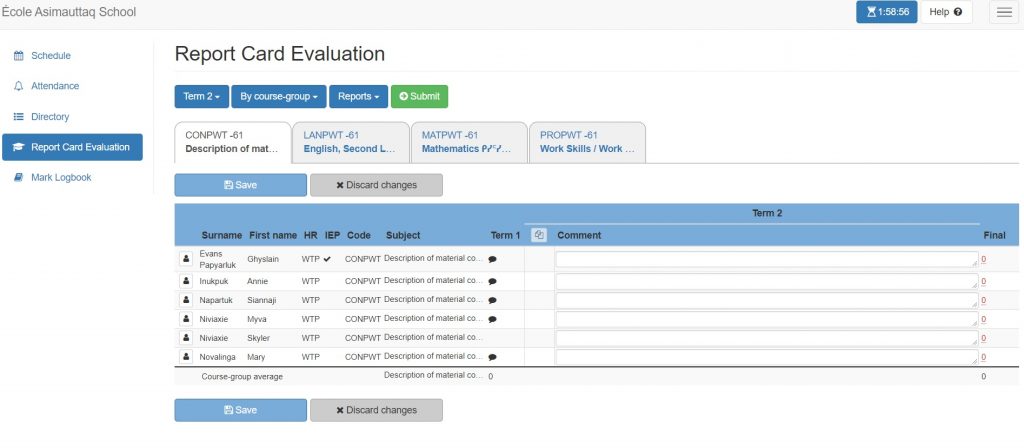
The second tab (PROPWT/TST) displays the pass/fail status, the student’s overall grade, number of absences and lates, and final comments about the students performance.
You must include the final mark and specify the pass or fail status of the student
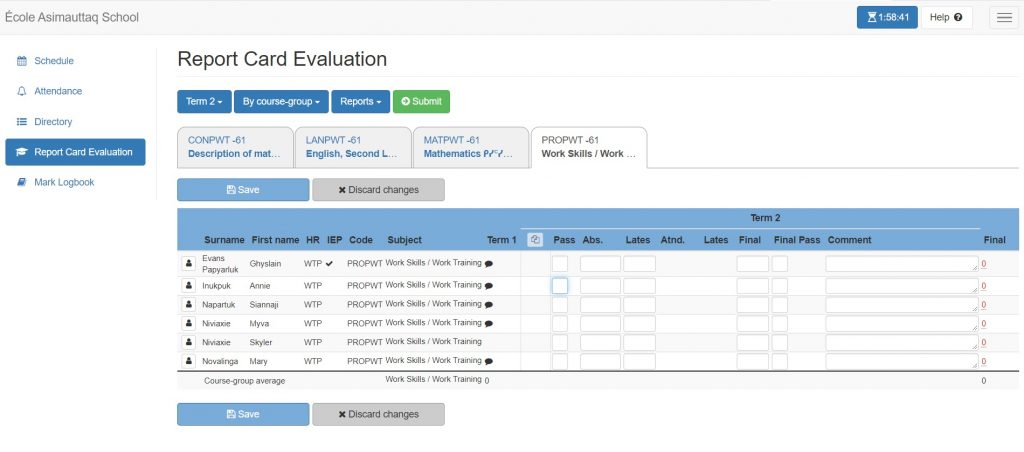
The IEP, Creation and Implementation for WOTP
Individualized Education Plan (IEP) is mandatory for admission to WOTP. It is a living document and should be updated as needed throughout the school year, with a complete review at the start of each school year. You should consult your students IEP to identify your student needs and the strategies that are in place for their success.
You may want to consult the documents from KI and the Ministry of Education for more details on the creation and implementation of IEPs. The creation of the IEP is not the sole responsibility of the teacher, each school should have a special education team. If for whatever reason your school does not have a special education team you can reach out to Complimentary Services (CCS) for assistance.
- Guide for the Development of IEP for Students with Specific Needs (English)
- Student Referral Procedure (English)
- Internal Referral Form (Tri-Lingual)
- IEP Form (English/Inuktitut)
- Complimentary Services Parental Consent Form (Tri-Lingual)
- Ministry of Education framework
Forms, Documents and Funding
Permission forms
Completing permission forms will be top priority in your first two weeks of school. WOTP relies heavily on activities outside of the school to improve student engagement. You are legally required to have these completed before you can leave the school grounds or you will be personally liable for any incidents.
We highly recommend that you assemble all of the forms listed below for your students in advance and clearly mark where signatures are required.
- General excursion form (English) (Inuktitut)
- Field Trip and excursion Policy (Appendix G for activities that require vehicles, firearms, overnight camping, etc.)
- Parental Permission for Admittance into WOTP
- Work-placement training permission form (Appendix G)
- Photo permission form (DB Server or available in your school)
- Health Form (DB Server or available in your school)
- Social Insurance Number
If you are teaching SST, completing the SIN application should be one of the first forms that you will fill with your students as it will be required for their work placement and future employment.
Keep in mind that the students are NOT to be paid during school time.
Ordering Materials through KI
You will be responsible for ordering your own materials. Please follow the instructions linked below. If you have any issues connecting to your account you may contact Jahlal Fattouh. (jalal.fattouh@kativik.qc.ca)
Once you receive your order form, you must send it to your principal who will sign and code it. The principal will then forward the order to the purchasing department. A teacher cannot approve their own orders.
You can check the status of all of your purchase orders by logging into your account and selecting the magnifying glass beside ‘Material Requisition’.
For more information, read this short guide (English)
Applying for Funding
The school budget is limited and is based on the number of students in your class, it will not likely cover your needs. Thankfully, there are many opportunities for funding your projects all around Nunavik, some funds come and go and can change each year. Here are the forms for the main funding sources used within KI.
- Healthy Schools
- New Paths for Education
- Stay-In-Schools (ENG) (FRA)
The applications for this program must be submitted the year prior. Some exceptions may be made for new hires outside of the deadlines.
Projects Ideas
Here are a few ideas of different projects you can do at your school.
You can also use this list of ideas used in different schools across the province. Clicking on the project’s name will bring you to its description.

Woodworking is a great project idea if your school has the tools. This sturdy bench was built at Arsiniq school in Kangigsujuaq.

Sautiuit School in Kangirsuk has a running skidoo garage.
Cooking traditional meals is always a winning option with students. Here you can see students from Ikusik school in Salluit preparing a goose.
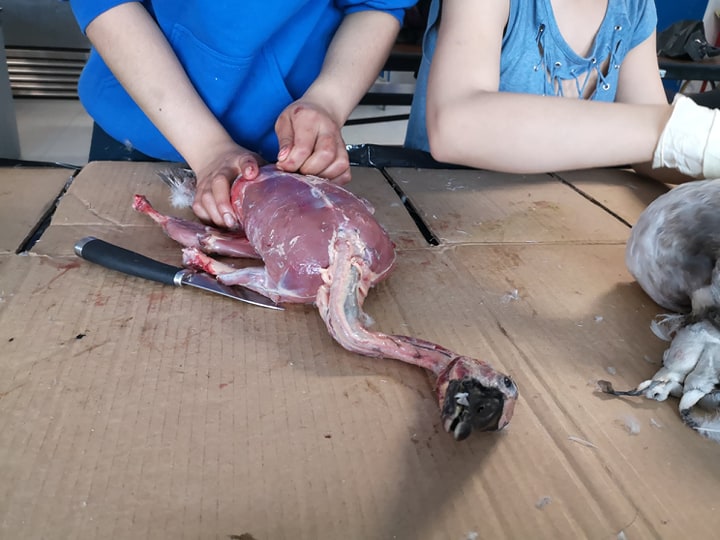

Each school will receive one Nutri-Tower indoor hydroponic garden to bolster their science and technology program.
In addition to the indoor garden, we have also ordered a dehydrator for each school for the making of traditional nikkuk and pitsik. This tool could also be used to make fruit leather or beef jerky.
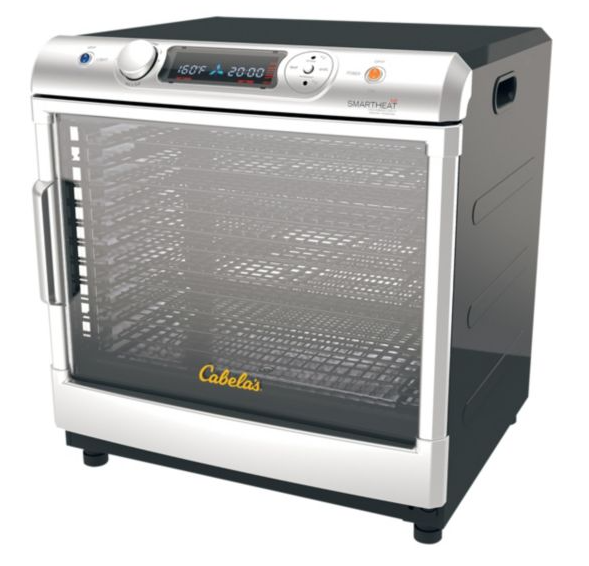

Other projects that were put in place in other schools include :
- Sewing (parka, pants, kamiks, handbags)
- Soap making
- School canteens
- Designing and producing cosmetics
- Jewelry making
- Outdoor activities
- Harvesting from the land
For better chances of participation from the students, the projects should give them just enough challenge that they will be able do to it without relying entirely on the teacher. Also, those projects should reflect situations and problems students may face in their day-to-day life.
